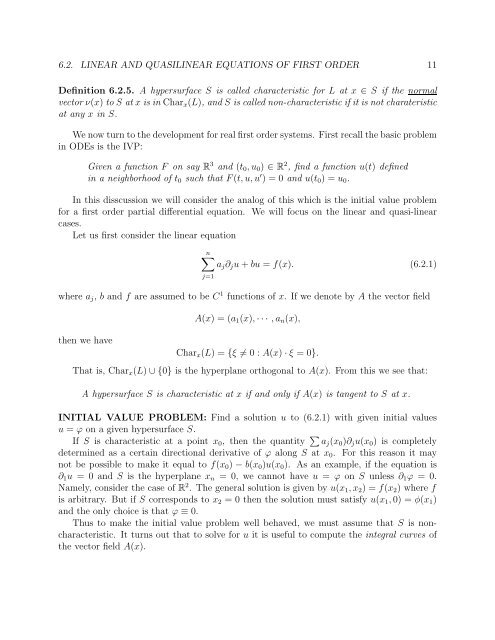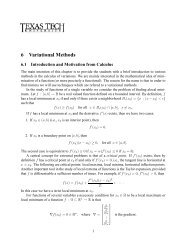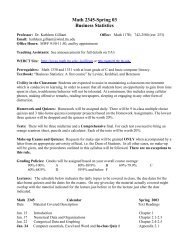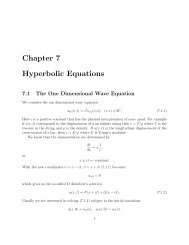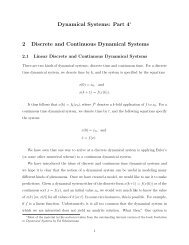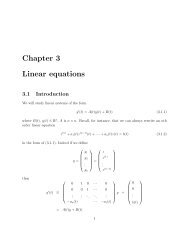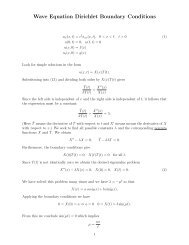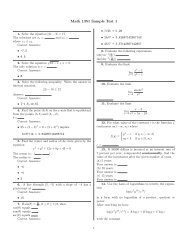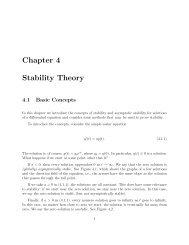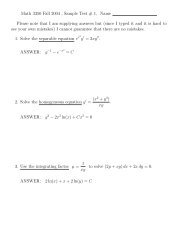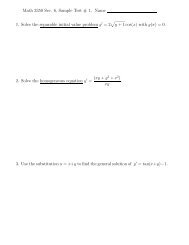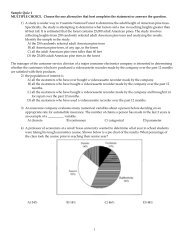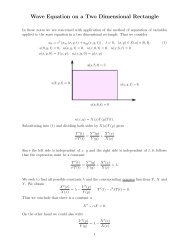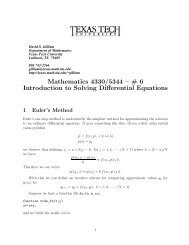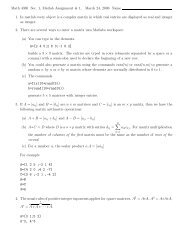Chapter 6 Partial Differential Equations
Chapter 6 Partial Differential Equations
Chapter 6 Partial Differential Equations
Create successful ePaper yourself
Turn your PDF publications into a flip-book with our unique Google optimized e-Paper software.
6.2. LINEAR AND QUASILINEAR EQUATIONS OF FIRST ORDER 11<br />
Definition 6.2.5. A hypersurface S is called characteristic for L at x ∈ S if the normal<br />
vector ν(x) to S at x is in Char x (L), and S is called non-characteristic if it is not charateristic<br />
at any x in S.<br />
We now turn to the development for real first order systems. First recall the basic problem<br />
in ODEs is the IVP:<br />
Given a function F on say R 3 and (t 0 ,u 0 ) ∈ R 2 , find a function u(t) defined<br />
in a neighborhood of t 0 such that F (t, u, u ′ )=0and u(t 0 )=u 0 .<br />
In this disscussion we will consider the analog of this which is the initial value problem<br />
for a first order partial differential equation. We will focus on the linear and quasi-linear<br />
cases.<br />
Let us first consider the linear equation<br />
n∑<br />
a j ∂ j u + bu = f(x). (6.2.1)<br />
j=1<br />
where a j , b and f are assumed to be C 1 functions of x. If we denote by A the vector field<br />
then we have<br />
A(x) =(a 1 (x), ··· ,a n (x),<br />
Char x (L) ={ξ ≠0:A(x) · ξ =0}.<br />
That is, Char x (L) ∪{0} is the hyperplane orthogonal to A(x). From this we see that:<br />
A hypersurface S is characteristic at x if and only if A(x) is tangent to S at x.<br />
INITIAL VALUE PROBLEM: Find a solution u to (6.2.1) with given initial values<br />
u = ϕ on a given hypersurface S.<br />
If S is characteristic at a point x 0 , then the quantity ∑ a j (x 0 )∂ j u(x 0 ) is completely<br />
determined as a certain directional derivative of ϕ along S at x 0 . For this reason it may<br />
not be possible to make it equal to f(x 0 ) − b(x 0 )u(x 0 ). As an example, if the equation is<br />
∂ 1 u = 0 and S is the hyperplane x n = 0, we cannot have u = ϕ on S unless ∂ 1 ϕ =0.<br />
Namely, consider the case of R 2 . The general solution is given by u(x 1 ,x 2 )=f(x 2 ) where f<br />
is arbitrary. But if S corresponds to x 2 = 0 then the solution must satisfy u(x 1 , 0) = φ(x 1 )<br />
and the only choice is that ϕ ≡ 0.<br />
Thus to make the initial value problem well behaved, we must assume that S is noncharacteristic.<br />
It turns out that to solve for u it is useful to compute the integral curves of<br />
the vector field A(x).


